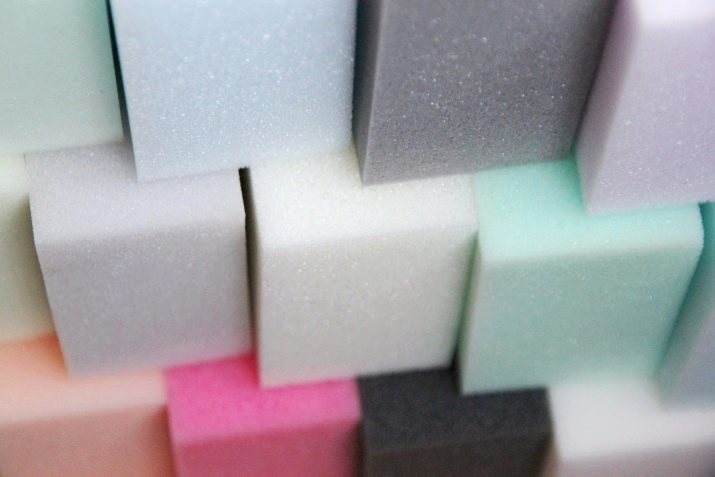Everything you need to know about floral sponges
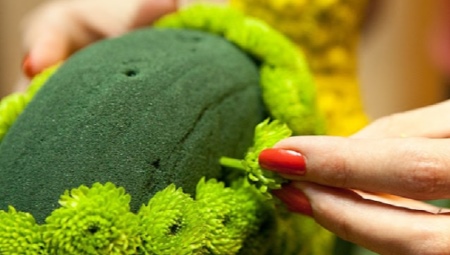
Floral sponges raise a lot of questions for novice flower designers: how to use them, how much to soak - beginners are interested in absolutely everything. It is really important to study the issue, because no complex floral arrangement can do without this element, also called "oasis". A detailed review will help you find out how the green foam for flowers and other sponges on sale today are different.
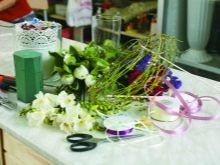
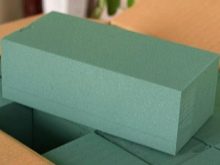
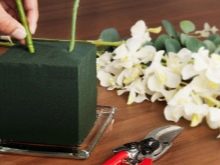
What is it and what is it made of?
Floristic sponge (oasis, piaflor) is a foamed material in sheets, solid when dry and elastic when wet. This is the base into which the stems of plants are inserted, which need fixation and moisture.
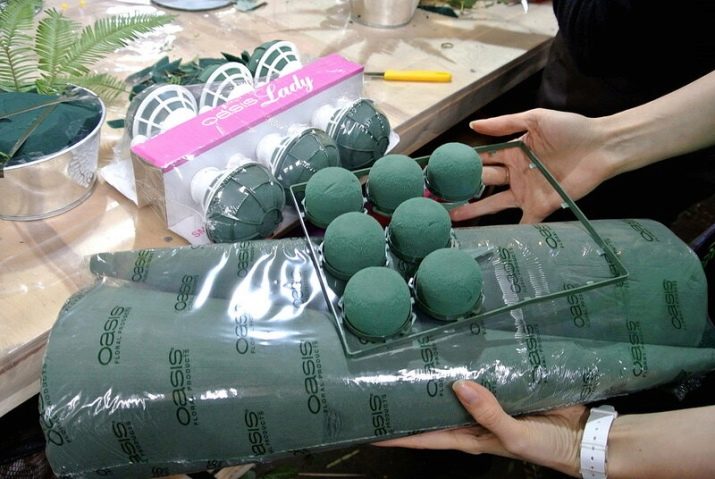
Flower foam can be made from a variety of materials. Most often, its composition is monolithic. When used as a base for plants that need water, the material is pre-impregnated.
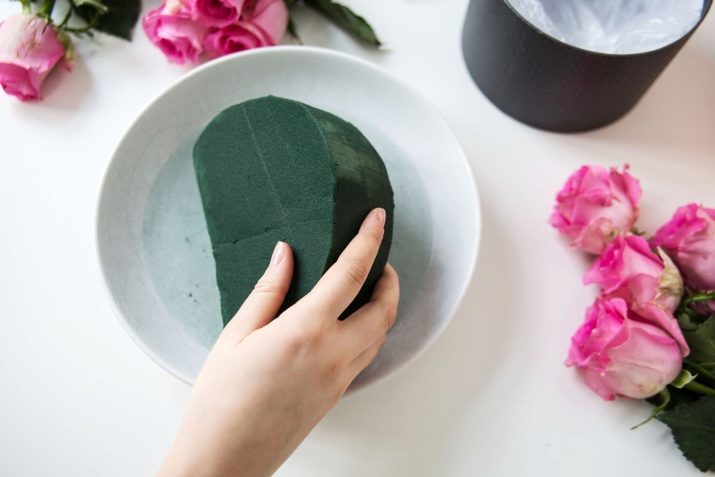
Sponges made of floristic foam, piaflore and polystyrene are separated - they have different densities, but all are capable of holding a mass of moisture 30 times their own weight. The characteristic features of oases for flower arrangements include:
- unlimited shelf life;
- elasticity;
- malleability for processing;
- ease of use;
- ease of storage and transportation.
Floral sponges are widely available in specialized stores. But before the purchase is made, you should figure out what the differences are in different options for such products.
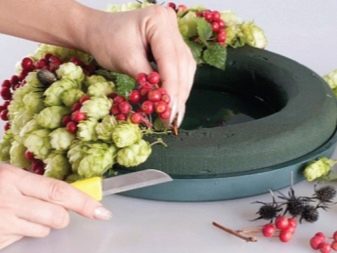
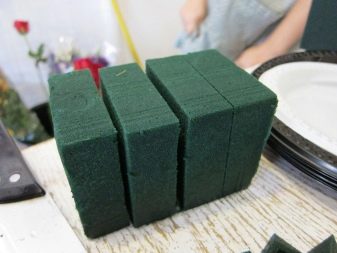
Description of species
Experienced florists know that different types of foam are required for bouquets and for creating compositions from dried flowers. Modern manufacturers offer customized solutions for box or basket installation where it is difficult to hide the surface of the base.
For these purposes, colored oases are specially produced in any desired shades.

As for the shape and size, here you can also find different options, from miniature to large, 50-70 cm in diameter. The classic floristic sponge is produced in the form of a brick, from which parts of the desired size are cut. Foam in briquettes is universal, suitable for those who prefer to shape the base themselves. Figured options - round, in the form of hemispheres, cubes, hearts, rings, animals, are intended for special compositions - voluminous, complex, thematic.

Green
This type of sponge is used for setting natural flowers. To compose bouquets of cut plants, use green foam, which collects water well and abundantly. A dry briquette is good for dried flowers, if there are no other options, it copes worse with fixing the stems than gray and brown types of foam.
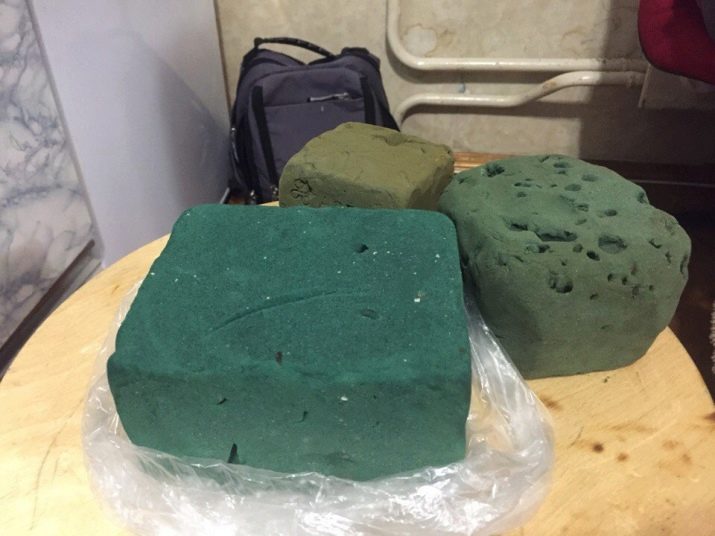
The difference between green oases and any other is that they are produced in different density options. The classification looks like this:
- "Ideal". Moderately dense sponge, considered versatile. This is a good choice for beginners as it allows you to work with plants with different types of stems.
- "Classic". Piaflor for plants with flexible stems.
- "Standard". Flower-oriented sponge with thin stems, miniature floristic compositions.
- "Premium". The densest foam, very resilient. It is used for planting plants with thick and not too flexible stems.
It is green piaflor that is most often used in the work of florists. But for solving specific problems, other options are better suited.
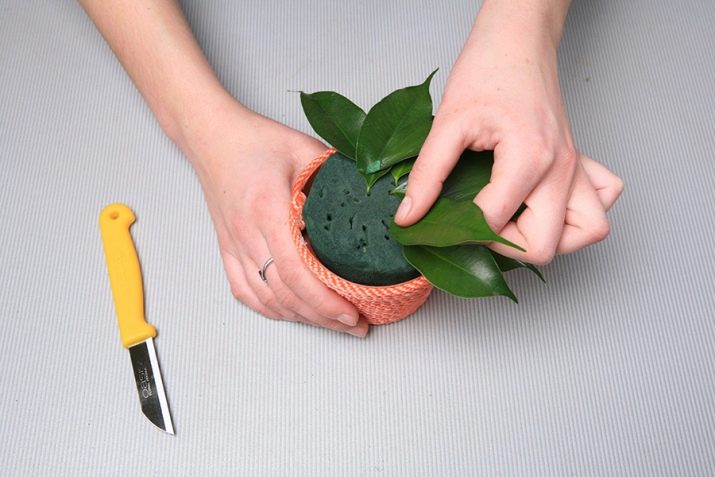
Gray
Special sponge for floristry. Designed to work with plants that do not require additional moisture.
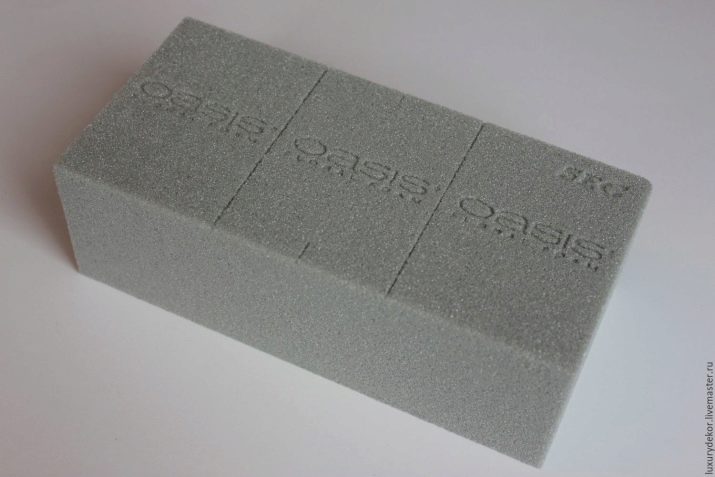
Brown
Sponges of this color are intended for artificial plants and dried flowers. They are not moistened before starting work, they are used dry. Working with the material requires some care, since it crumbles heavily without soaking.
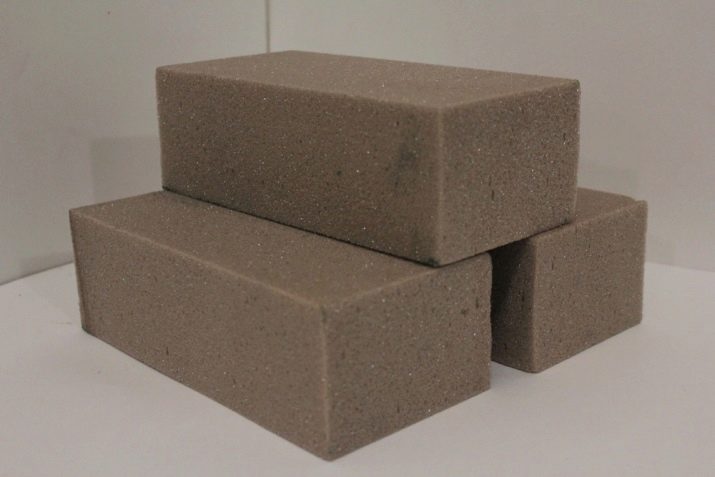
Nuances of choice
Before buying a floral sponge for the first time, beginners have many questions. Determining the purpose of the purchase in this case is no less important than giving preference to the correct brand of goods.
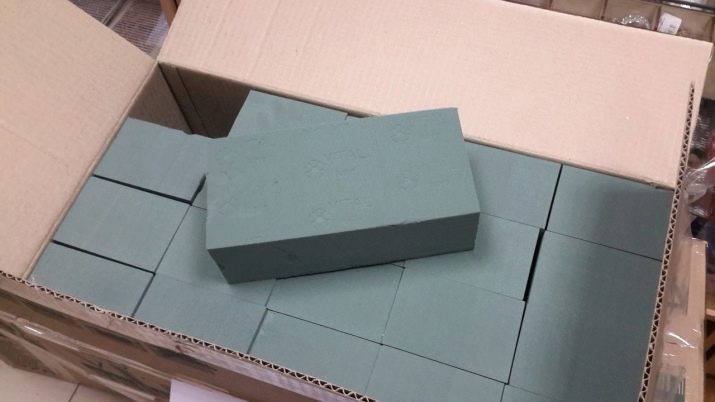
Among the main selection criteria to which it is recommended to pay attention, it is possible to note:
- Bouquet type. When it comes to dried flowers, succulents, artificial compositions, you can get by with gray or brown types of foam. In other cases, only a green sponge is useful, which is chosen taking into account how thick and stubborn stems are to be fixed in it.
- The complexity of the composition. It is better to immediately assemble the curly options on the appropriate frame. It can be cut from a briquette, but the finished sponges look noticeably neater and more presentable, and the choice of shapes and sizes is impressive even for experienced florists.
- Brand. Nobody forbids ordering goods from unknown sources on Chinese Internet aggregators. Professionals most often use products from the market leader - OASIS. It is she who has everything you need to draw up beautiful and complex bouquets, compositions in a box or basket.
- The presence of flora components. These ingredients provide a nutrient medium for cut flowers. If you have to collect a bouquet on a damp sponge, the flora ingredients are required. In addition, you need to take care that they do not dissolve when soaking - you can immerse piaflor in liquid for only 1 minute.
- Integrity of the packaging. It is very important. The floral sponge should have a polyethylene sheath that is sufficiently tight. A product with signs of damage, crumbling, broken off should not be bought.

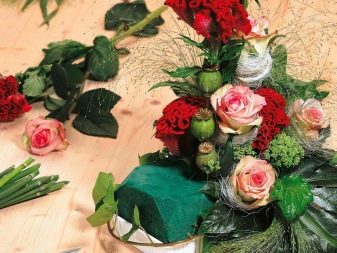
These are the basic selection rules that should be followed when choosing a floral sponge.
You should look for a quality product in specialized stores or garden centers, checking the compliance with the storage conditions.
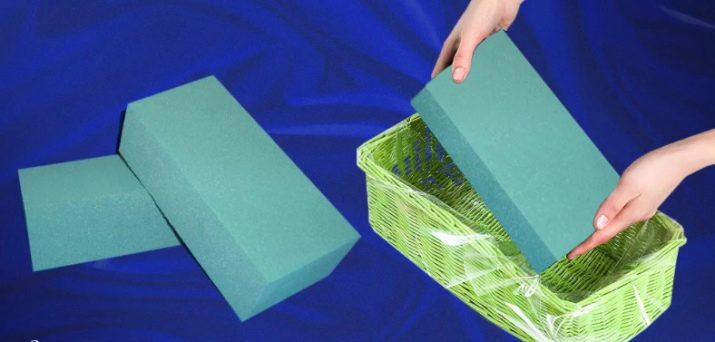
How to use it correctly?
Starting to work with a floral sponge, it is difficult for a beginner to avoid mistakes. In order to prevent possible misses, the instructions for use should be strictly followed.
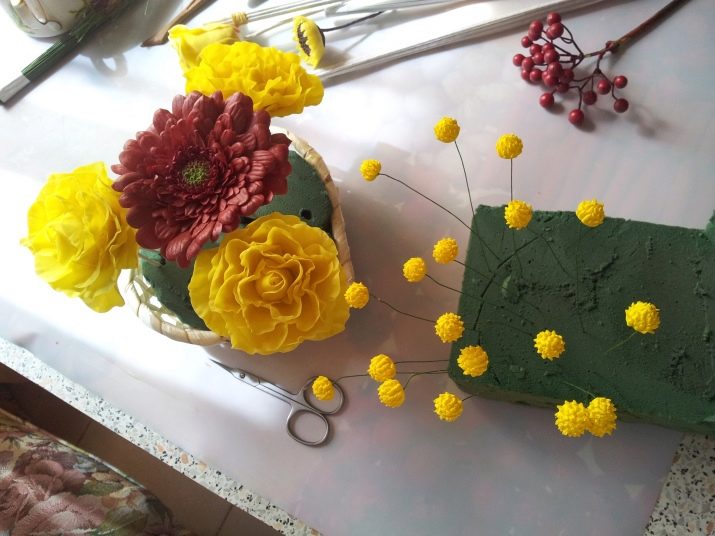
Among the important points that will have to be taken into account when working with piaflor, it is worth highlighting:
- Exact size matching of the sponge and the base of the composition. You cannot use random components. First, a base is selected - a stand or container, then the piaflor is cut out.
- Compliance with cutting technology. For cutting, you can use a dry or damp sponge - in this case, you will have to soak it first. Cutting is done with a clerical knife. It is worth considering that dry pyaflor is very dusty when cutting.
- Soaking out of time. You can only prepare a floristic sponge for use by placing it in water. The liquid level should be twice the height of the piaflore itself. There is no need to heat or water the sponge from above, trying to quickly saturate it - the foam itself will pick up the required amount of moisture. According to the technology, the stamp of the manufacturer's company name on the sponge should be directed upward when soaking - this will preserve the concentration of nutrients, prevent them from dissolving ahead of time.
- Storage taking into account the individual characteristics of the material. All floral sponges can be reused several times. Gray and brown are easy to use even after drying. But the green one must be kept moist, wrapping the excess with cling film, and then placing it in an airtight container.
- Usage. To assemble the composition, a wet or dry sponge is placed in a prepared container. If we are talking about a possible leakage of moisture, it is better to wrap the bottom of the piaflore with film or foil before laying it on the bottom. Only the upper part remains open.
- Care. Ready-made flower arrangements with a floral sponge at the base require some attention. Every 4-5 days, the oasis is moistened by simply watering it in 3 places. It is worth checking the sponge beforehand. If its surface is not dry enough, you can postpone watering.
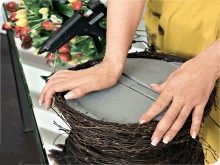
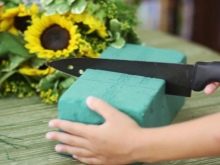
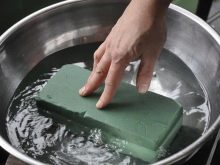
These are the basic rules to consider when working with a floral sponge. By following them, you can avoid many common mistakes that lead to the loss of valuable material.
What can be replaced?
In search of a material that can be used instead of a floral sponge, experts sometimes go to different tricks. Most often, natural materials are used as an alternative to dense foam. For example, a plastic bag tightly packed with wet sand. It can be used as an alternative when assembling small arrangements of flowers with solid stems.
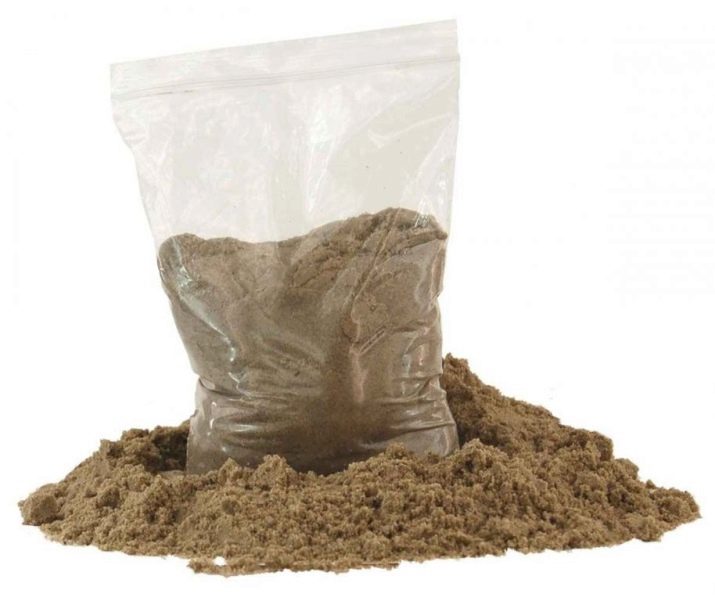
If thinner stems are to be fastened, there are other options for replacing piaflora. Its place will be taken by a lump of sphagnum, Icelandic or lichen moss, lichen or similar species will do. In such a frame, fresh flowers feel pretty good. At the same time, moisture remains for a long time.

Styrofoam or expanded polystyrene is an artificial replacement for the classic floral sponge. These options are best used when working with dried flowers. Here they will be quite appropriate. Styrofoam that does not absorb water is more likely to harm living plants.
